Calculus Assignment: Comprehensive Solutions for Differentiation Tasks
VerifiedAdded on 2023/06/10
|12
|1799
|243
Homework Assignment
AI Summary
This calculus assignment provides detailed solutions to various problems, including finding the maximum area of a rectangular enclosure using differentiation, differentiating complex functions using product and chain rules, and solving indefinite integrals using substitution and integration by parts. The assignment also covers the evaluation of definite integrals, solving systems of linear equations using matrices, and determining matrix invertibility. Numerical solutions and step-by-step explanations are provided to aid understanding, with references to advanced calculus resources for further study. Desklib offers students access to this solution and numerous other solved assignments.

Calculus
Institution Name
Student Name
Date
Institution Name
Student Name
Date
Paraphrase This Document
Need a fresh take? Get an instant paraphrase of this document with our AI Paraphraser
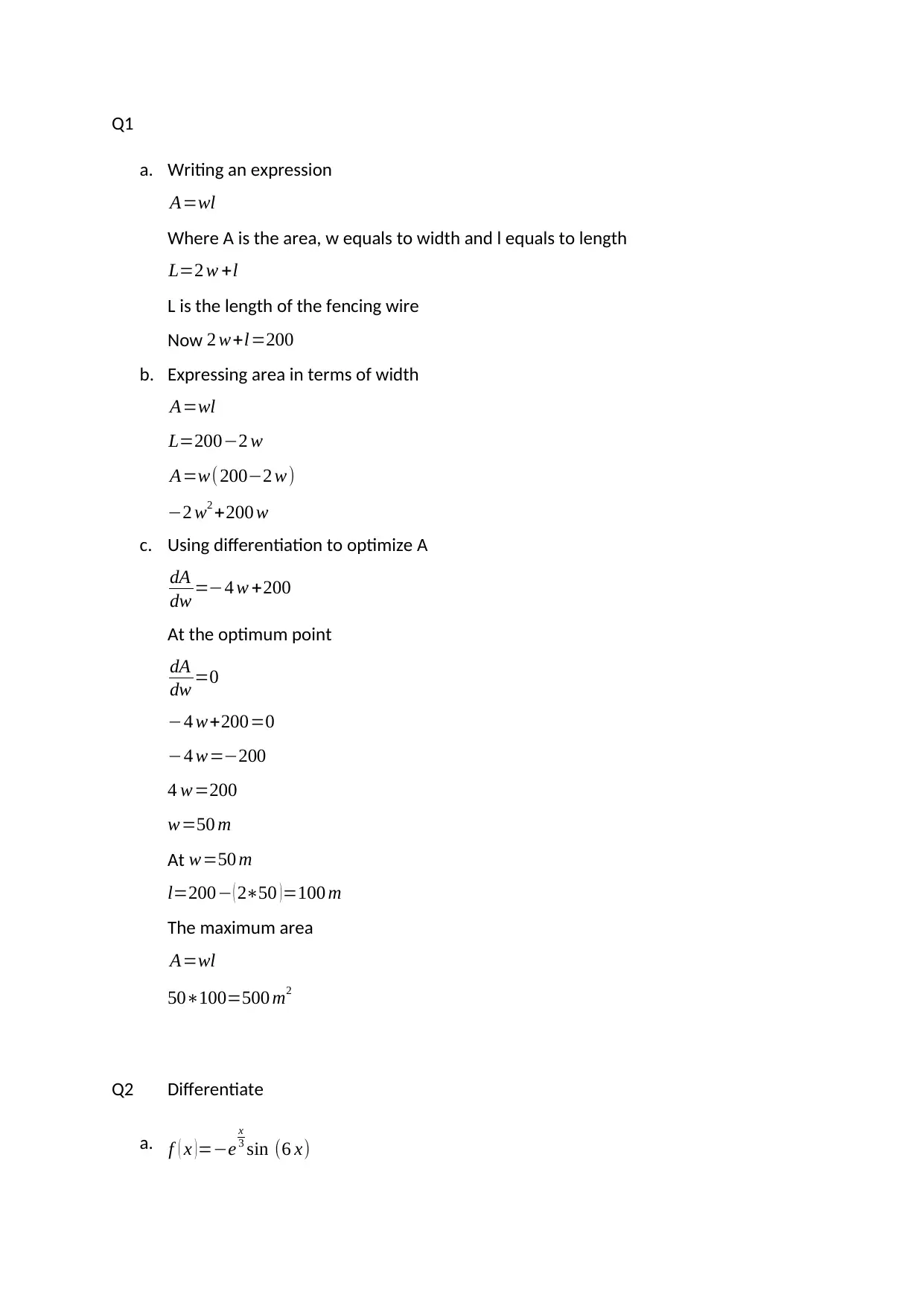
Q1
a. Writing an expression
A=wl
Where A is the area, w equals to width and l equals to length
L=2 w +l
L is the length of the fencing wire
Now 2 w+l=200
b. Expressing area in terms of width
A=wl
L=200−2 w
A=w( 200−2 w)
−2 w2 +200 w
c. Using differentiation to optimize A
dA
dw =−4 w +200
At the optimum point
dA
dw =0
−4 w+200=0
−4 w=−200
4 w=200
w=50 m
At w=50 m
l=200− ( 2∗50 )=100 m
The maximum area
A=wl
50∗100=500 m2
Q2 Differentiate
a. f ( x ) =−e
x
3 sin (6 x)
a. Writing an expression
A=wl
Where A is the area, w equals to width and l equals to length
L=2 w +l
L is the length of the fencing wire
Now 2 w+l=200
b. Expressing area in terms of width
A=wl
L=200−2 w
A=w( 200−2 w)
−2 w2 +200 w
c. Using differentiation to optimize A
dA
dw =−4 w +200
At the optimum point
dA
dw =0
−4 w+200=0
−4 w=−200
4 w=200
w=50 m
At w=50 m
l=200− ( 2∗50 )=100 m
The maximum area
A=wl
50∗100=500 m2
Q2 Differentiate
a. f ( x ) =−e
x
3 sin (6 x)
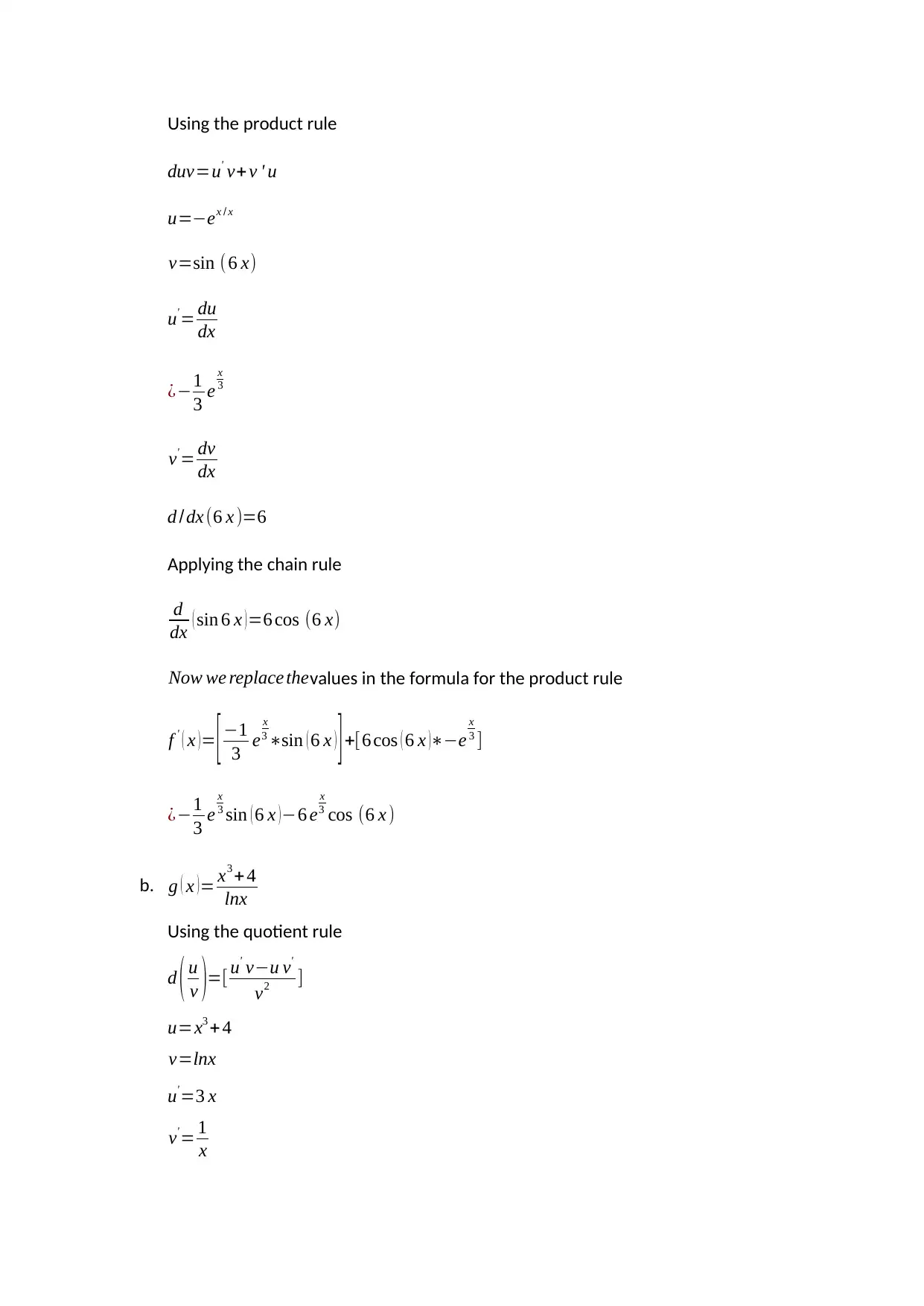
Using the product rule
duv=u' v+ v ' u
u=−ex / x
v=sin (6 x)
u'= du
dx
¿−1
3 e
x
3
v'= dv
dx
d /dx (6 x )=6
Applying the chain rule
d
dx ( sin 6 x ) =6 cos (6 x)
Now we replace thevalues in the formula for the product rule
f ' ( x )= [−1
3 e
x
3 ∗sin ( 6 x ) ]+[6 cos ( 6 x )∗−e
x
3 ]
¿−1
3 e
x
3 sin ( 6 x )−6 e
x
3 cos (6 x )
b. g ( x ) = x3 + 4
lnx
Using the quotient rule
d ( u
v )=[ u' v−u v'
v2 ]
u=x3 + 4
v=lnx
u'=3 x
v'= 1
x
duv=u' v+ v ' u
u=−ex / x
v=sin (6 x)
u'= du
dx
¿−1
3 e
x
3
v'= dv
dx
d /dx (6 x )=6
Applying the chain rule
d
dx ( sin 6 x ) =6 cos (6 x)
Now we replace thevalues in the formula for the product rule
f ' ( x )= [−1
3 e
x
3 ∗sin ( 6 x ) ]+[6 cos ( 6 x )∗−e
x
3 ]
¿−1
3 e
x
3 sin ( 6 x )−6 e
x
3 cos (6 x )
b. g ( x ) = x3 + 4
lnx
Using the quotient rule
d ( u
v )=[ u' v−u v'
v2 ]
u=x3 + 4
v=lnx
u'=3 x
v'= 1
x
⊘ This is a preview!⊘
Do you want full access?
Subscribe today to unlock all pages.

Trusted by 1+ million students worldwide

g' ( x ) =
3 xlnx− ( x3+ 4 ) ( 1
x )
( lnx )2
c. h ( t )= (ln ( 3 t ) +2t
1
2 )2
3
using the chain rule
h' ( t ) ={ 2
3 (ln ( 3 t ) +2 t
1
2 )(−1 /3) }∗{( 3∗1
3 t ) +t
−1
2 }
¿ {2
3 (ln ( 3 t )+2 t
1
2 )−1
3
}{ 1
t +t
−1
2 }
Q3 Indefinite integral
f ( x ) =x ( 1
2 ) (x ¿¿ 2+2)( x +3)¿
Removing the brackets
(x
5
2 + 2 x
1
2 )( x +3)
x
7
2 + 3 x
5
2 +2x
3
2 +6 x
1
2
` Now using the addition/sum rule and the power rule we integrate the polynomial
∫ x
7
2 +3 x
5
2 +2 x
3
2 + 6 x
1
2
¿ x
9
2
9
2
+ 3 x
7
2
7
2
+ 2 x
5
2
5
2
+ 6 x
3
2
3
2
x
9
2
9
2
+ x
7
2
6
7
+ x
5
2
4
5
+ x
3
2
4
Q4 Integration by substitution
a. ∫ sinx
( 5−3 cosx )3 dx
u=5−3 cosx
3 xlnx− ( x3+ 4 ) ( 1
x )
( lnx )2
c. h ( t )= (ln ( 3 t ) +2t
1
2 )2
3
using the chain rule
h' ( t ) ={ 2
3 (ln ( 3 t ) +2 t
1
2 )(−1 /3) }∗{( 3∗1
3 t ) +t
−1
2 }
¿ {2
3 (ln ( 3 t )+2 t
1
2 )−1
3
}{ 1
t +t
−1
2 }
Q3 Indefinite integral
f ( x ) =x ( 1
2 ) (x ¿¿ 2+2)( x +3)¿
Removing the brackets
(x
5
2 + 2 x
1
2 )( x +3)
x
7
2 + 3 x
5
2 +2x
3
2 +6 x
1
2
` Now using the addition/sum rule and the power rule we integrate the polynomial
∫ x
7
2 +3 x
5
2 +2 x
3
2 + 6 x
1
2
¿ x
9
2
9
2
+ 3 x
7
2
7
2
+ 2 x
5
2
5
2
+ 6 x
3
2
3
2
x
9
2
9
2
+ x
7
2
6
7
+ x
5
2
4
5
+ x
3
2
4
Q4 Integration by substitution
a. ∫ sinx
( 5−3 cosx )3 dx
u=5−3 cosx
Paraphrase This Document
Need a fresh take? Get an instant paraphrase of this document with our AI Paraphraser
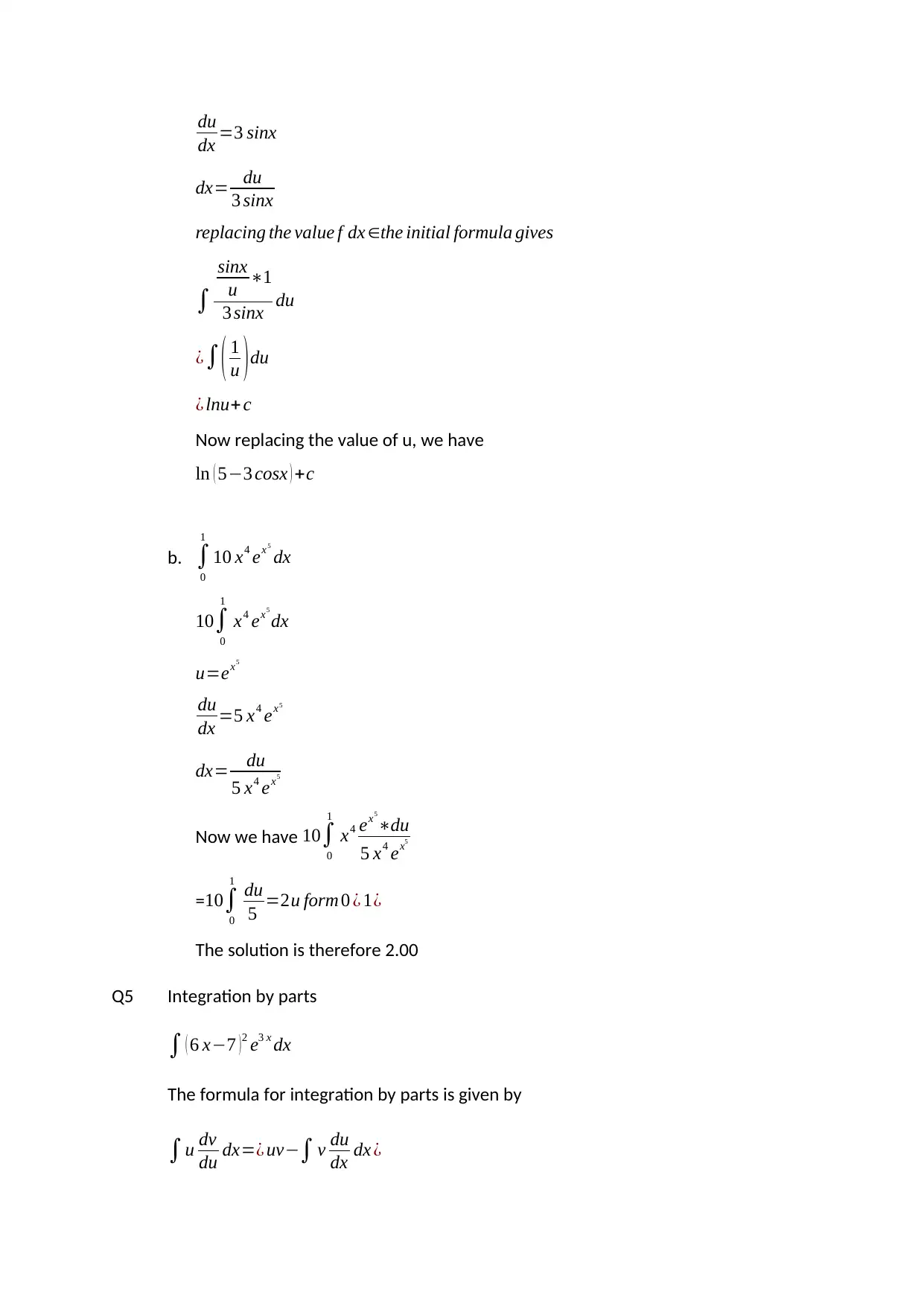
du
dx =3 sinx
dx= du
3 sinx
replacing the value f dx ∈the initial formula gives
∫
sinx
u ∗1
3 sinx du
¿∫ ( 1
u )du
¿ lnu+ c
Now replacing the value of u, we have
ln ( 5−3 cosx ) +c
b. ∫
0
1
10 x4 ex5
dx
10∫
0
1
x4 ex5
dx
u=ex5
du
dx =5 x4 ex5
dx= du
5 x4 ex5
Now we have 10∫
0
1
x4 ex5
∗du
5 x4 ex5
=10∫
0
1
du
5 =2u form 0 ¿ 1¿
The solution is therefore 2.00
Q5 Integration by parts
∫ ( 6 x−7 )2 e3 x dx
The formula for integration by parts is given by
∫u dv
du dx=¿ uv−∫ v du
dx dx ¿
dx =3 sinx
dx= du
3 sinx
replacing the value f dx ∈the initial formula gives
∫
sinx
u ∗1
3 sinx du
¿∫ ( 1
u )du
¿ lnu+ c
Now replacing the value of u, we have
ln ( 5−3 cosx ) +c
b. ∫
0
1
10 x4 ex5
dx
10∫
0
1
x4 ex5
dx
u=ex5
du
dx =5 x4 ex5
dx= du
5 x4 ex5
Now we have 10∫
0
1
x4 ex5
∗du
5 x4 ex5
=10∫
0
1
du
5 =2u form 0 ¿ 1¿
The solution is therefore 2.00
Q5 Integration by parts
∫ ( 6 x−7 )2 e3 x dx
The formula for integration by parts is given by
∫u dv
du dx=¿ uv−∫ v du
dx dx ¿

Using the liatec rule
For ( 6 x−7 )2 e3 x dx
u= ( 6 x−7 ) 2
dv
dx =e3 x
Afterwards we begin the integration of
∫ ( 6 x−7 )2 e3 x dx
u= ( 6 x−7 ) 2
du
dx =2 ( 6 x−7 )∗6=12(6 x−7)
v=∫ e3 x= 1
3 e3 x
dv
dx =e3 x
Now replacing the values in the integration by parts formula, we obtain.
( 6 x−7 ) 2∗1
3 ∗−e3 x−∫¿ ¿
Solving the integration part, we have
∫¿ ¿
4∫ ¿ ¿
We again use the integration by parts formula since the terms are a multipole of
Functions
The parts formula gives
u=6 x−7
dv
dx =e3 x
For ( 6 x−7 )2 e3 x dx
u= ( 6 x−7 ) 2
dv
dx =e3 x
Afterwards we begin the integration of
∫ ( 6 x−7 )2 e3 x dx
u= ( 6 x−7 ) 2
du
dx =2 ( 6 x−7 )∗6=12(6 x−7)
v=∫ e3 x= 1
3 e3 x
dv
dx =e3 x
Now replacing the values in the integration by parts formula, we obtain.
( 6 x−7 ) 2∗1
3 ∗−e3 x−∫¿ ¿
Solving the integration part, we have
∫¿ ¿
4∫ ¿ ¿
We again use the integration by parts formula since the terms are a multipole of
Functions
The parts formula gives
u=6 x−7
dv
dx =e3 x
⊘ This is a preview!⊘
Do you want full access?
Subscribe today to unlock all pages.

Trusted by 1+ million students worldwide
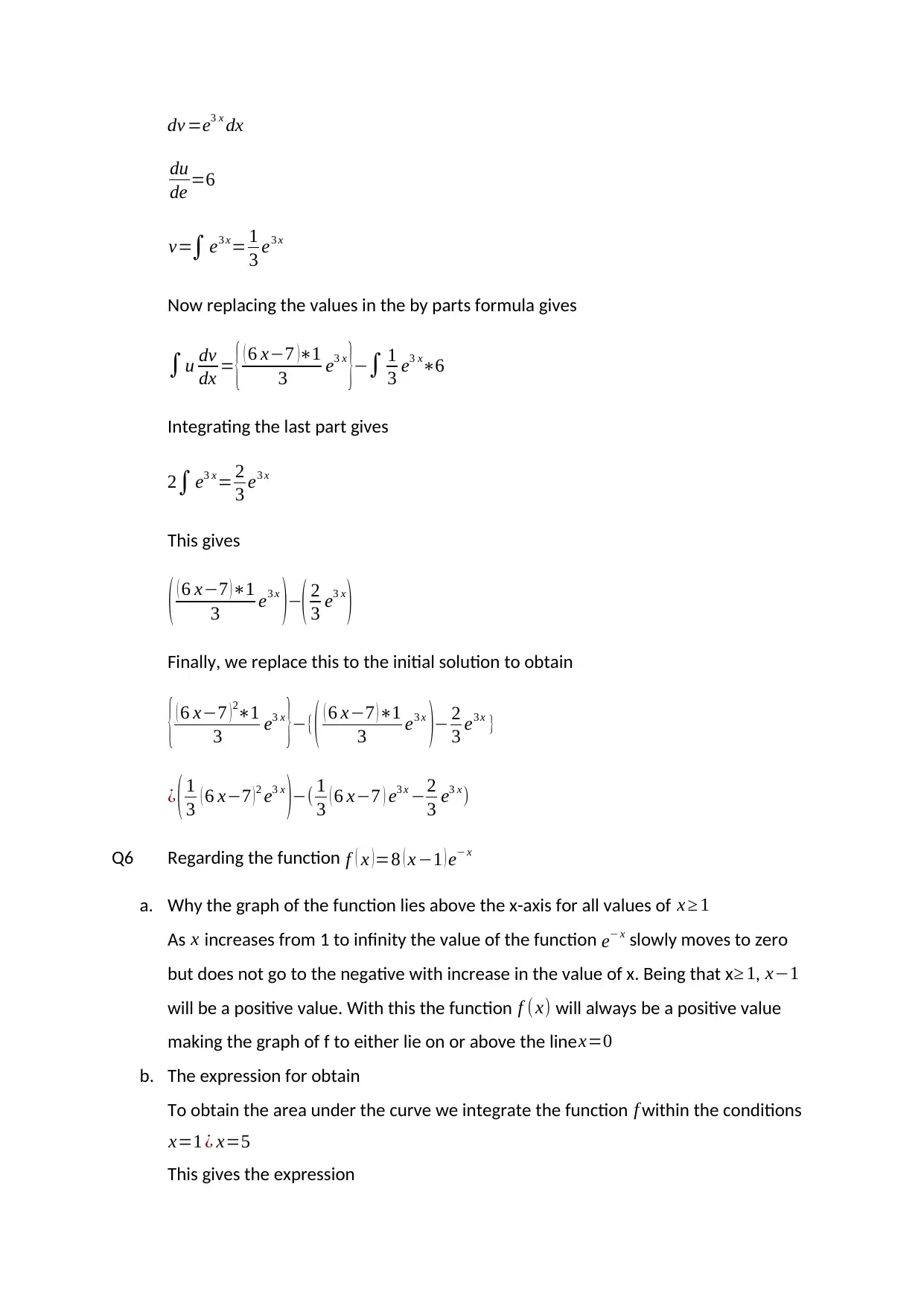
dv =e3 x dx
du
de =6
v=∫ e3 x= 1
3 e3 x
Now replacing the values in the by parts formula gives
∫u dv
dx = { ( 6 x−7 )∗1
3 e3 x
}−∫ 1
3 e3 x∗6
Integrating the last part gives
2∫ e3 x= 2
3 e3 x
This gives
( ( 6 x−7 ) ∗1
3 e3 x
)−( 2
3 e3 x
)
Finally, we replace this to the initial solution to obtain
{ ( 6 x−7 )2∗1
3 e3 x
}−{( ( 6 x−7 )∗1
3 e3 x
)− 2
3 e3 x }
¿ ( 1
3 ( 6 x−7 )2 e3 x
)−( 1
3 ( 6 x−7 ) e3 x −2
3 e3 x)
Q6 Regarding the function f ( x ) =8 ( x −1 ) e− x
a. Why the graph of the function lies above the x-axis for all values of x ≥ 1
As x increases from 1 to infinity the value of the function e− x slowly moves to zero
but does not go to the negative with increase in the value of x. Being that x ≥ 1, x−1
will be a positive value. With this the function f ( x) will always be a positive value
making the graph of f to either lie on or above the line x=0
b. The expression for obtain
To obtain the area under the curve we integrate the function f within the conditions
x=1 ¿ x=5
This gives the expression
du
de =6
v=∫ e3 x= 1
3 e3 x
Now replacing the values in the by parts formula gives
∫u dv
dx = { ( 6 x−7 )∗1
3 e3 x
}−∫ 1
3 e3 x∗6
Integrating the last part gives
2∫ e3 x= 2
3 e3 x
This gives
( ( 6 x−7 ) ∗1
3 e3 x
)−( 2
3 e3 x
)
Finally, we replace this to the initial solution to obtain
{ ( 6 x−7 )2∗1
3 e3 x
}−{( ( 6 x−7 )∗1
3 e3 x
)− 2
3 e3 x }
¿ ( 1
3 ( 6 x−7 )2 e3 x
)−( 1
3 ( 6 x−7 ) e3 x −2
3 e3 x)
Q6 Regarding the function f ( x ) =8 ( x −1 ) e− x
a. Why the graph of the function lies above the x-axis for all values of x ≥ 1
As x increases from 1 to infinity the value of the function e− x slowly moves to zero
but does not go to the negative with increase in the value of x. Being that x ≥ 1, x−1
will be a positive value. With this the function f ( x) will always be a positive value
making the graph of f to either lie on or above the line x=0
b. The expression for obtain
To obtain the area under the curve we integrate the function f within the conditions
x=1 ¿ x=5
This gives the expression
Paraphrase This Document
Need a fresh take? Get an instant paraphrase of this document with our AI Paraphraser
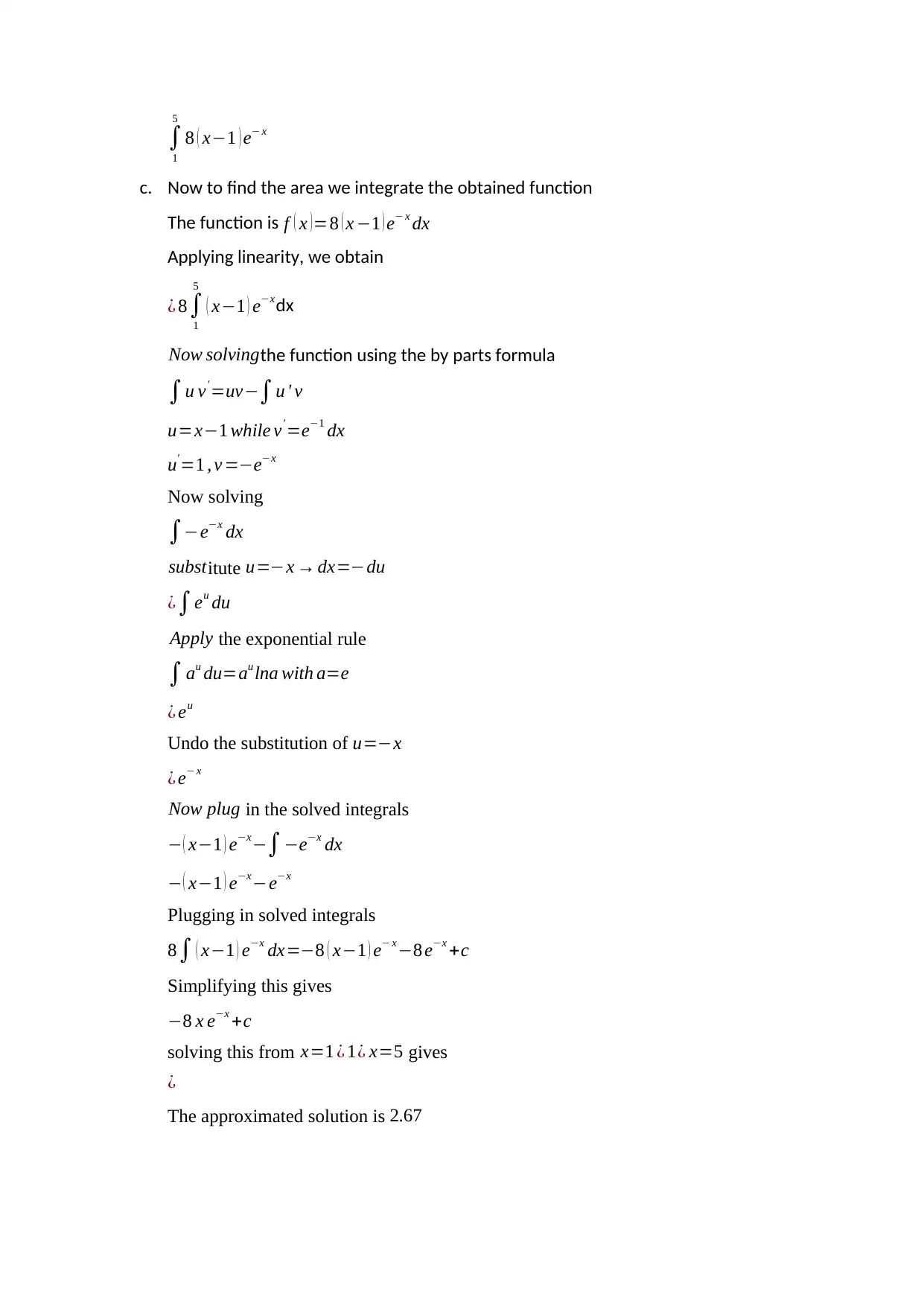
∫
1
5
8 ( x−1 ) e− x
c. Now to find the area we integrate the obtained function
The function is f ( x )=8 ( x −1 ) e− x dx
Applying linearity, we obtain
¿ 8∫
1
5
( x−1 ) e−xdx
Now solvingthe function using the by parts formula
∫u v' =uv−∫u ' v
u=x−1 while v' =e−1 dx
u'=1 , v =−e−x
Now solving
∫−e−x dx
substitute u=−x → dx=−du
¿∫eu du
Apply the exponential rule
∫ au du=au lna with a=e
¿ eu
Undo the substitution of u=−x
¿ e− x
Now plug in the solved integrals
− ( x−1 ) e−x−∫−e−x dx
− ( x−1 ) e−x−e−x
Plugging in solved integrals
8∫ ( x−1 ) e−x dx=−8 ( x−1 ) e− x−8 e−x +c
Simplifying this gives
−8 x e−x +c
solving this from x=1 ¿ 1¿ x=5 gives
¿
The approximated solution is 2.67
1
5
8 ( x−1 ) e− x
c. Now to find the area we integrate the obtained function
The function is f ( x )=8 ( x −1 ) e− x dx
Applying linearity, we obtain
¿ 8∫
1
5
( x−1 ) e−xdx
Now solvingthe function using the by parts formula
∫u v' =uv−∫u ' v
u=x−1 while v' =e−1 dx
u'=1 , v =−e−x
Now solving
∫−e−x dx
substitute u=−x → dx=−du
¿∫eu du
Apply the exponential rule
∫ au du=au lna with a=e
¿ eu
Undo the substitution of u=−x
¿ e− x
Now plug in the solved integrals
− ( x−1 ) e−x−∫−e−x dx
− ( x−1 ) e−x−e−x
Plugging in solved integrals
8∫ ( x−1 ) e−x dx=−8 ( x−1 ) e− x−8 e−x +c
Simplifying this gives
−8 x e−x +c
solving this from x=1 ¿ 1¿ x=5 gives
¿
The approximated solution is 2.67
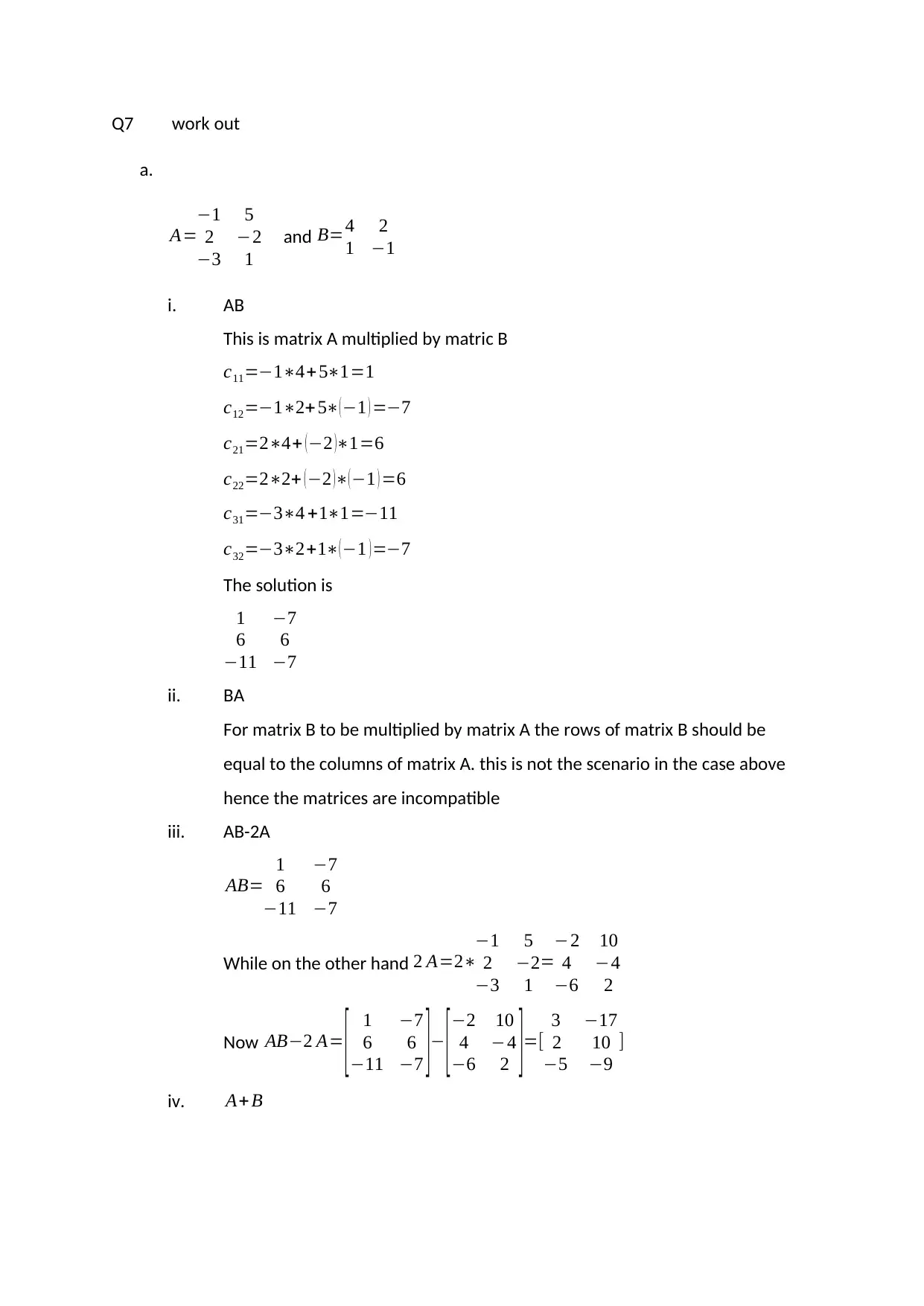
Q7 work out
a.
A=
−1 5
2 −2
−3 1
and B=4 2
1 −1
i. AB
This is matrix A multiplied by matric B
c11=−1∗4+ 5∗1=1
c12=−1∗2+ 5∗( −1 ) =−7
c21=2∗4+ ( −2 )∗1=6
c22=2∗2+ (−2 )∗(−1 ) =6
c31=−3∗4 +1∗1=−11
c32=−3∗2+1∗(−1 )=−7
The solution is
1 −7
6 6
−11 −7
ii. BA
For matrix B to be multiplied by matrix A the rows of matrix B should be
equal to the columns of matrix A. this is not the scenario in the case above
hence the matrices are incompatible
iii. AB-2A
AB=
1 −7
6 6
−11 −7
While on the other hand 2 A=2∗
−1 5
2 −2
−3 1
=
−2 10
4 −4
−6 2
Now AB−2 A= [ 1 −7
6 6
−11 −7 ]− [−2 10
4 −4
−6 2 ]=[
3 −17
2 10
−5 −9
]
iv. A+B
a.
A=
−1 5
2 −2
−3 1
and B=4 2
1 −1
i. AB
This is matrix A multiplied by matric B
c11=−1∗4+ 5∗1=1
c12=−1∗2+ 5∗( −1 ) =−7
c21=2∗4+ ( −2 )∗1=6
c22=2∗2+ (−2 )∗(−1 ) =6
c31=−3∗4 +1∗1=−11
c32=−3∗2+1∗(−1 )=−7
The solution is
1 −7
6 6
−11 −7
ii. BA
For matrix B to be multiplied by matrix A the rows of matrix B should be
equal to the columns of matrix A. this is not the scenario in the case above
hence the matrices are incompatible
iii. AB-2A
AB=
1 −7
6 6
−11 −7
While on the other hand 2 A=2∗
−1 5
2 −2
−3 1
=
−2 10
4 −4
−6 2
Now AB−2 A= [ 1 −7
6 6
−11 −7 ]− [−2 10
4 −4
−6 2 ]=[
3 −17
2 10
−5 −9
]
iv. A+B
⊘ This is a preview!⊘
Do you want full access?
Subscribe today to unlock all pages.

Trusted by 1+ million students worldwide
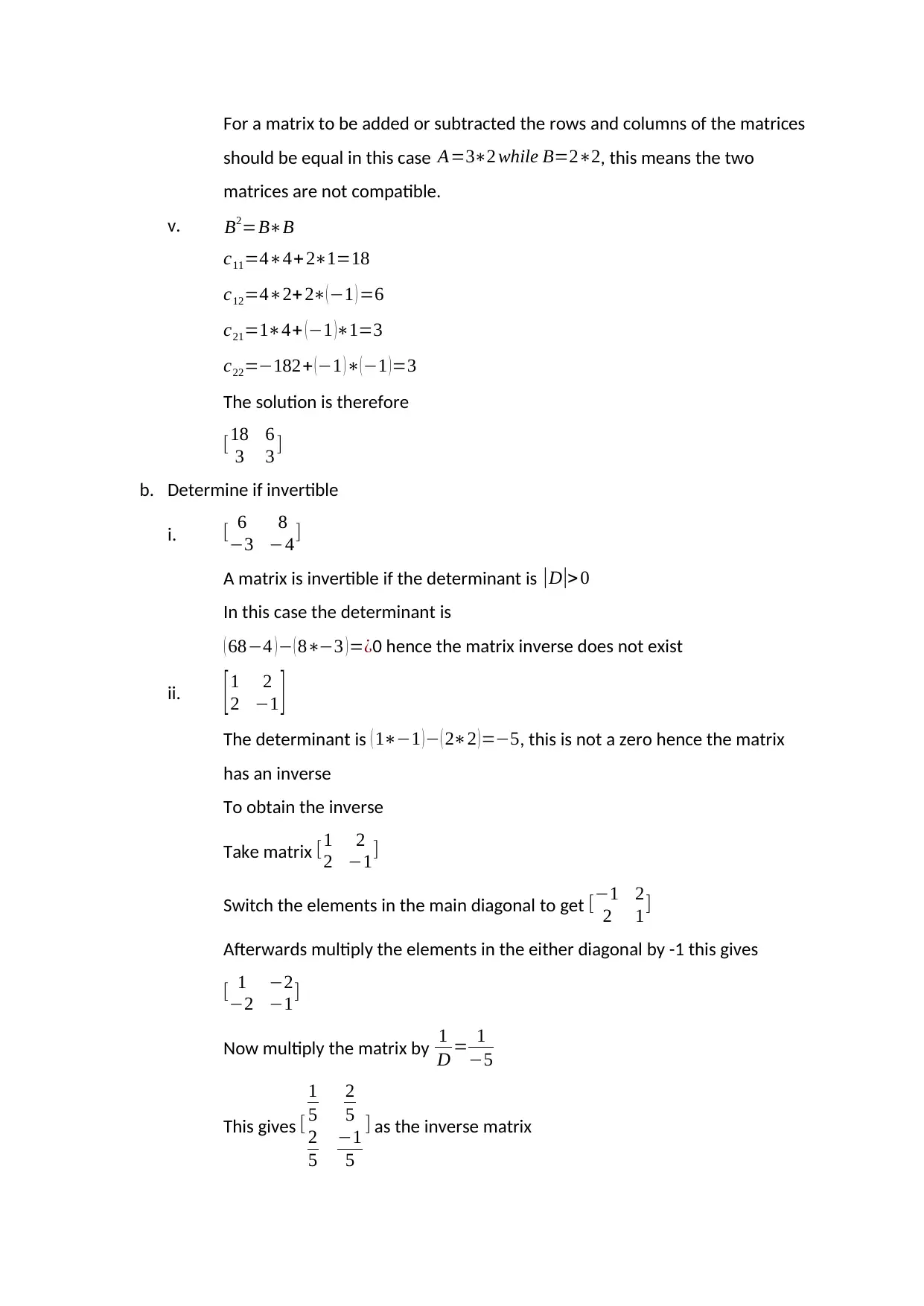
For a matrix to be added or subtracted the rows and columns of the matrices
should be equal in this case A=3∗2 while B=2∗2, this means the two
matrices are not compatible.
v. B2=B∗B
c11=4∗4+ 2∗1=18
c12=4∗2+ 2∗( −1 ) =6
c21=1∗4+ (−1 )∗1=3
c22=−182+ ( −1 ) ∗( −1 ) =3
The solution is therefore
[18 6
3 3 ]
b. Determine if invertible
i. [ 6 8
−3 −4]
A matrix is invertible if the determinant is |D|> 0
In this case the determinant is
( 68−4 )− ( 8∗−3 )=¿0 hence the matrix inverse does not exist
ii. [ 1 2
2 −1 ]
The determinant is ( 1∗−1 )− ( 2∗2 )=−5, this is not a zero hence the matrix
has an inverse
To obtain the inverse
Take matrix [1 2
2 −1]
Switch the elements in the main diagonal to get [−1 2
2 1]
Afterwards multiply the elements in the either diagonal by -1 this gives
[ 1 −2
−2 −1]
Now multiply the matrix by 1
D = 1
−5
This gives [
1
5
2
5
2
5
−1
5
] as the inverse matrix
should be equal in this case A=3∗2 while B=2∗2, this means the two
matrices are not compatible.
v. B2=B∗B
c11=4∗4+ 2∗1=18
c12=4∗2+ 2∗( −1 ) =6
c21=1∗4+ (−1 )∗1=3
c22=−182+ ( −1 ) ∗( −1 ) =3
The solution is therefore
[18 6
3 3 ]
b. Determine if invertible
i. [ 6 8
−3 −4]
A matrix is invertible if the determinant is |D|> 0
In this case the determinant is
( 68−4 )− ( 8∗−3 )=¿0 hence the matrix inverse does not exist
ii. [ 1 2
2 −1 ]
The determinant is ( 1∗−1 )− ( 2∗2 )=−5, this is not a zero hence the matrix
has an inverse
To obtain the inverse
Take matrix [1 2
2 −1]
Switch the elements in the main diagonal to get [−1 2
2 1]
Afterwards multiply the elements in the either diagonal by -1 this gives
[ 1 −2
−2 −1]
Now multiply the matrix by 1
D = 1
−5
This gives [
1
5
2
5
2
5
−1
5
] as the inverse matrix
Paraphrase This Document
Need a fresh take? Get an instant paraphrase of this document with our AI Paraphraser
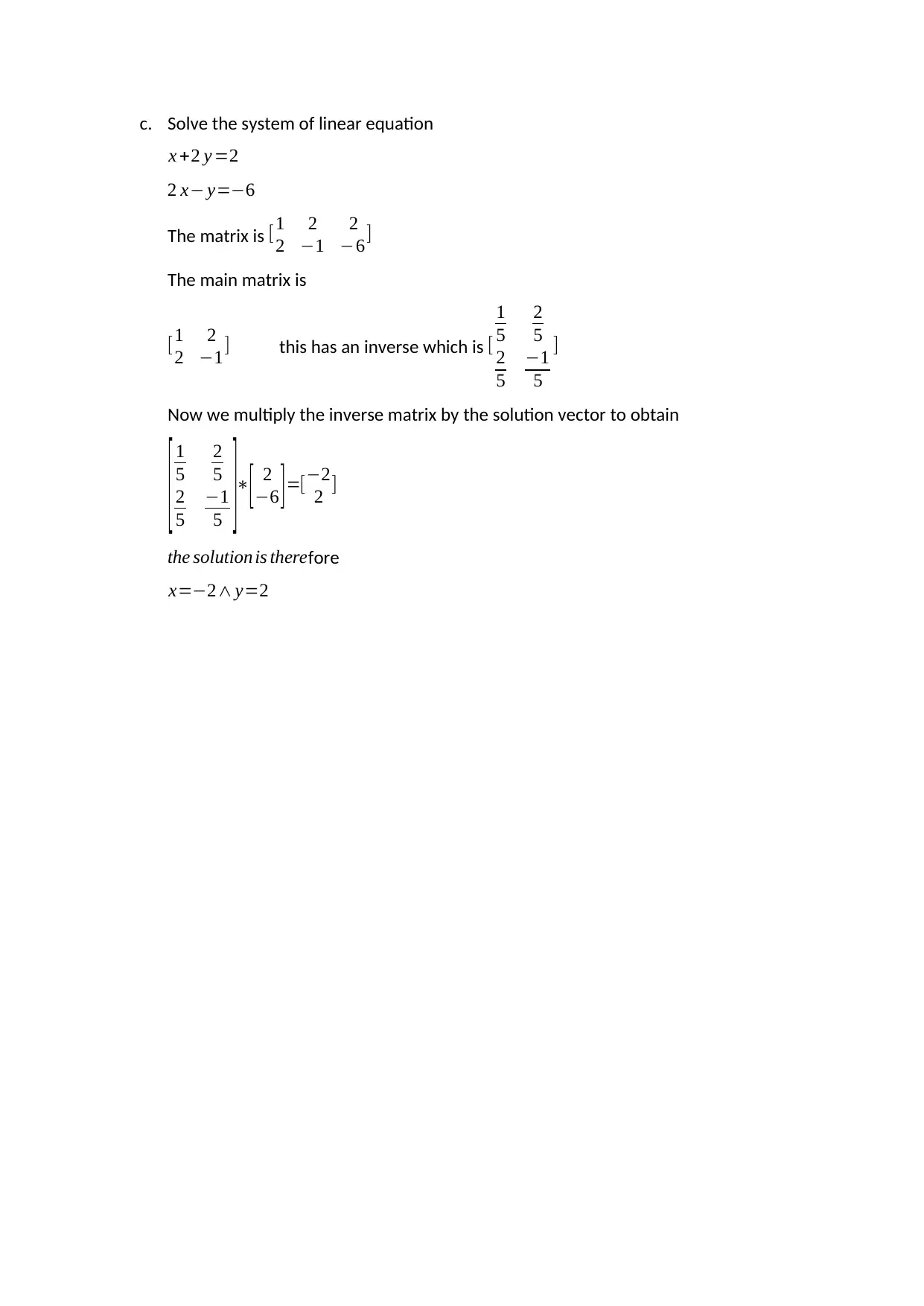
c. Solve the system of linear equation
x +2 y =2
2 x− y=−6
The matrix is [1 2 2
2 −1 −6]
The main matrix is
[1 2
2 −1] this has an inverse which is [
1
5
2
5
2
5
−1
5
]
Now we multiply the inverse matrix by the solution vector to obtain
[ 1
5
2
5
2
5
−1
5 ]∗[ 2
−6 ] =[−2
2 ]
the solution is therefore
x=−2∧ y=2
x +2 y =2
2 x− y=−6
The matrix is [1 2 2
2 −1 −6]
The main matrix is
[1 2
2 −1] this has an inverse which is [
1
5
2
5
2
5
−1
5
]
Now we multiply the inverse matrix by the solution vector to obtain
[ 1
5
2
5
2
5
−1
5 ]∗[ 2
−6 ] =[−2
2 ]
the solution is therefore
x=−2∧ y=2

References
Fitzpatrick, P. M. (2006). Advance Calculus. Belmont, CA: Thompson Brooks/Cole.
Rogers, R. C. (2011). The Calculus of Several Variables.
Fitzpatrick, P. M. (2006). Advance Calculus. Belmont, CA: Thompson Brooks/Cole.
Rogers, R. C. (2011). The Calculus of Several Variables.
⊘ This is a preview!⊘
Do you want full access?
Subscribe today to unlock all pages.

Trusted by 1+ million students worldwide
1 out of 12
Related Documents
Your All-in-One AI-Powered Toolkit for Academic Success.
+13062052269
info@desklib.com
Available 24*7 on WhatsApp / Email
![[object Object]](/_next/static/media/star-bottom.7253800d.svg)
Unlock your academic potential
Copyright © 2020–2025 A2Z Services. All Rights Reserved. Developed and managed by ZUCOL.





